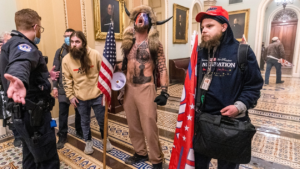The Court’s Republican supermajority will hear a case about the Commerce Clause. God help us.
The Supreme Court announced on Monday that it would hear four cases challenging the Indian Child Welfare Act (ICWA), a 1978 law enacted to prevent states from breaking up American Indian families and removing American Indian children from their indigenous cultures.
The four cases will likely be consolidated under the name Haaland v. Brackeen. But the most alarming of these four cases is Texas v. Haaland, because that case targets a provision of the Constitution that is the foundation of much of the federal government’s power.
In the worst-case scenario for, well, pretty much everyone who doesn’t share Clarence Thomas or Neil Gorsuch’s policy preferences, the Texas case could do considerable violence to a wide range of federal laws — including the ban on child labor, the ban on whites-only lunch counters, the Affordable Care Act, and nearly all federal laws governing the workplace.
The Constitution permits Congress to “regulate commerce with foreign nations, and among the several states, and with the Indian tribes.” This power to regulate commerce is the basis of the modern American regulatory state, and it includes the federal government’s respective powers to set a minimum wage, protect the right to unionize, prohibit discrimination by private businesses, and protect the environment.
(Federal statutes and court opinions frequently refer to Native Americans as “Indians.” For this reason, this piece will include many quotes and legal references that also use this terminology.)
Indeed, the overwhelming majority of federal laws governing private companies exist because of this commerce power.
But the Supreme Court hasn’t always respected Congress’s broad power to regulate the national economy. In the late 19th and early 20th centuries, the Court adopted an exceedingly narrow reading of the Constitution’s Commerce Clause — and then used that reading to strike down child labor laws, sabotage antitrust laws, and strip workers of their right to organize.
This miserly reading of the Commerce Clause is now ascendant on the far right of the judiciary — Justice Thomas is its most prominent evangelist. And Texas is the first Commerce Clause case to reach the justices since Republicans gained a 6-3 supermajority on the nation’s highest court. So it could give us our first window into how the Court’s new majority views this singularly important constitutional question.
The Indian Child Welfare Act, briefly explained
The ICWA was enacted in response to a centurieslong effort to, as federal Judge James Dennis described it, “‘Christianize’ the supposedly heathen Native peoples.” As far back as the George Washington administration, Congress provided funding to raise Native children in white Quaker homes. Beginning in the 1800s, the federal government forcibly removed Native children from their homes and enrolled them in boarding schools intended to divorce them from their tribe’s culture.
As Commissioner of Indian Affairs T.J. Morgan described this project in 1896, its very purpose was “for the strong arm of the nation to reach out, take [American Indians] in their infancy and place them in its fostering schools, surrounding them with an atmosphere of civilization … instead of allowing them to grow up as barbarians and savages.”
Though these federal boarding schools declined over the course of the 20th century, state governments continued to remove Native children from their families into the 1970s. As Judge Dennis writes, “surveys of states with large Indian populations during the 1960s and 1970s showed that between twenty-five to thirty-five percent of all Indian children were removed from their families.” A survey of 16 states, conducted in 1969, found that “approximately 85% of all Indian children in foster care were living in non-Indian homes.”
The ICWA sought to put an end to this practice of tearing Native children from their homes and placing them in unfamiliar settings — often with white families. Among other things, it provides that, if a state court determines that a child who is either “a member of an Indian tribe” or “is eligible for membership in an Indian tribe and is the biological child of a member of an Indian tribe” must be removed from their home, then the state typically should place that child in another American Indian home:
The various parties challenging the ICWA raise several objections to the law. Their strongest argument is that the law violates the “anti-commandeering doctrine,” a legal doctrine that strictly limits the federal government’s ability to compel state governments to behave in a certain way. The ICWA would be less vulnerable to this attack if it transferred child welfare cases involving Native children to federal courts, rather than regulating how state courts should handle these cases.
Some parties challenging the ICWA also claim that the law is unconstitutional because it classifies children based on race — although astute readers of the ICWA will notice that it does no such thing. It classifies children based on their membership in (or eligibility for membership in) a tribe, and this is not a racial classification. Some tribes, for example, offer tribal citizenship to the descendants of Black people who were enslaved by members of the tribe, even though these Black tribal members may not be blood descendants of the tribe’s indigenous members.
And then there’s the claim that the ICWA exceeds Congress’s power to regulate under the Commerce Clause.
A brief history of the Commerce Clause
Recall that the Commerce Clause actually gives Congress three separate powers. It permits the federal government to regulate commerce “with foreign nations, and among the several states, and with the Indian tribes.” The Court has, at various times, read Congress’s power to regulate commerce with tribal and foreign nations much more expansively than its power to regulate commerce “among the several states.”
The “Indian Commerce Clause”
The Court held in Cotton Petroleum Corp. v. New Mexico (1989) that “the central function of the Indian Commerce Clause is to provide Congress with plenary power to legislate in the field of Indian affairs” — “plenary power” means that Congress can do whatever it wants, provided that it does not violate any of the individual rights protected by the Constitution.
From the earliest days of the American Republic, the federal government was understood to have wide discretion to set policy with respect to Native American tribes. In 1789, for example, Secretary of War Henry Knox wrote to President George Washington that “the independent nations and tribes of Indians ought to be considered as foreign nations, not as the subjects of any particular state.” He later wrote that “the United States have, under the constitution, the sole regulation of Indian affairs, in all matters whatsoever.”
Thus, much like the federal government has one national policy toward Russia, France, or Mozambique — not 50 different policies set by 50 different states — it must also have a single national policy with respect to tribal relations. And this policy must be set by Congress, the only legislative body that speaks for the entire nation.
The “Interstate Commerce Clause”
The history of the Interstate Commerce Clause — the provision permitting Congress to regulate commerce “among the several states” — is much more fraught.
For those who want the longer version of this history, I spend several chapters discussing it in my first book, Injustices: The Supreme Court’s History of Comforting the Comfortable and Afflicting the Afflicted, but the short version goes something like this:
Early Americans lived in a nation where local marketplaces were often quite distinct from the economy of the nation as a whole. A farmer in Iowa, for example, would grow their grain in Iowan land, sell it in a nearby town to other Iowans, and never really compete with other farmers in other states.
As the United States industrialized, however, it built a nationwide network of railroads to transport goods among the states. In this industrialized nation, the same Iowa farmer’s grain would be shipped to Chicago on a rail car, where it would be intermingled with grain grown by farmers throughout the Midwest. Then it might eventually be sold to consumers in New York or Virginia or even somewhere overseas.
This economic history matters because the framers intended for the Interstate Commerce Clause to give Congress the power to regulate the national marketplace — what one early Supreme Court case described as “commerce which concerns more States than one.” Meanwhile, state governments would retain exclusive authority over purely local marketplaces.
But in a modern, industrialized economy, there’s no such thing as a purely local marketplace. Merchants routinely trade across state lines. And even if an individual merchant only trades locally with residents of the same state, that local merchant’s goods compete with other goods produced in other states, which impacts the price of those goods throughout the country.
And so Congress’s power to regulate interstate commerce grew to encompass the entire national economy — and every economic transaction that impacts that economy. As the Court held in United States v. Morrison (2000), Congress’s power to regulate interstate commerce extends to all “activities that substantially affect interstate commerce.”
There are, however, some limits on Congress’s power to act under the Interstate Commerce Clause.
For several decades, beginning in the late 19th century, the Court placed artificial limits on this power — most notably, the Court permitted Congress to regulate the transport of goods across state lines, but not the actual production of those goods. This distinction formed the basis of the Court’s decision in Hammer v. Dagenhart (1918), for example, which struck down a federal law seeking to ban child labor.
But this distinction between transport and production proved unworkable, not just because it led to cruel results like the one in Dagenhart, but because there’s no clear line between a law that regulates the production of a good and a law regulating its sale across state lines. Even if Congress can’t ban factories from employing 8-year-olds, why can’t it ban those factories from transporting goods produced by children across state lines?
Modern-day cases such as Morrison, by contrast, draw a distinction between economic and non-economic activity. Congress’s authority over economic matters is quite expansive, but the interstate commerce power does not apply to many non-economic activities.
So Congress could not pass a nationwide ban on assault, for example, because beating someone up is not an economic activity and typically does not have much of an impact on the national economy. And, for similar reasons, family law — the body of law governing marriages, divorces, child custody, and the like — is typically beyond the reach of Congress’s power over interstate commerce.
Which brings us back to the Indian Child Welfare Act.
Texas wants the Supreme Court to erase the distinction between the Indian Commerce Clause and the Interstate Commerce Clause
The primary thrust of the state of Texas’s argument in Texas v. Haaland is that the vision of Congress’s power over American Indian affairs that has prevailed since the Washington administration is wrong, and that “the notion that Congress has plenary power over some vaguely defined area of ‘Indian affairs’ ‘rests on shak[y] foundations.’”
Instead, Texas would have the Supreme Court read the Indian Commerce Clause and the Interstate Commerce Clause to “mean substantially the same thing.”
The immediate impact of such a decision is that it would likely doom the ICWA, and permit state courts — including Texas’s courts — to make child custody decisions that violate the ICWA. Again, the interstate commerce power typically does not permit Congress to regulate the family. So, if Congress’s power over Native American affairs is similarly limited, then the ICWA is in deep trouble.
And a decision redefining the Indian Commerce Clause to be coextensive with the Interstate Commerce Clause would also mean that anything the Supreme Court says about the scope of the former clause would also impact the later clause. That is, if the Court’s decision in Texas includes language limiting Congress’s ability to pass laws governing American Indians, that same language could also place limits on Congress’s much broader power to enact economic regulations such as the minimum wage or the Affordable Care Act.
One might expect the Supreme Court to show some humility when it is asked to scrap an understanding of the Constitution that has prevailed for more than 200 years. But that has not always been the Roberts Court’s practice. And it certainly hasn’t been the practice of so-called “originalist” justices, who frequently argue that their understanding of the Constitution’s text should prevail, even if it is at odds with decades or even centuries of precedent.
Justice Thomas has even argued that the Court should bring back the unworkable distinction between laws regulating transit of goods and laws regulating production — the very same legal reasoning that the Court once used to strike down child labor laws.
Realistically, there probably aren’t five votes on this Supreme Court to force children back into cotton mills. But every time the Court takes up a Commerce Clause case, the stakes are astronomically high. And we don’t really know yet how this Court’s 6-3 Republican majority will approach this all-important clause.
And even if the Court decides that a case about Native American children isn’t the proper vehicle to roll back the modern understanding of the Interstate Commerce Clause, the Court’s present majority is likely to stick around for many years. Which means they have many years to find other cases that they can use to set fire to one of the most important provisions of the Constitution.




